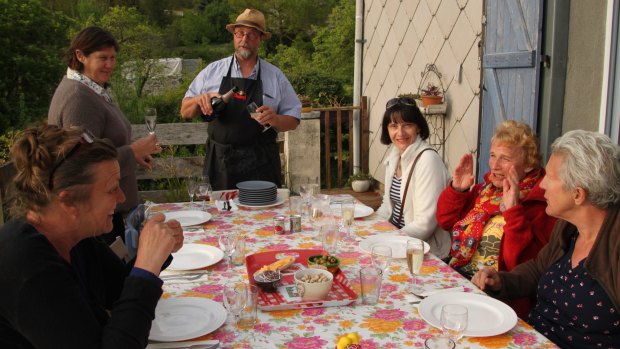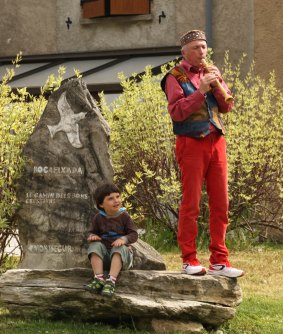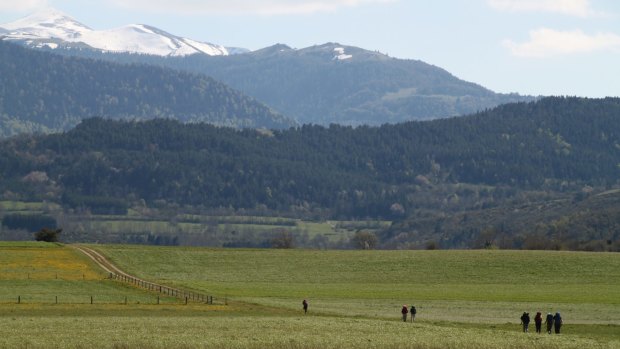This was published 7 years ago
Walking the Languedoc, France: The walk that ends with wine and cheese

Dinner at In Focus B&B.Credit: Richard Tulloch
"Glory, glory, Halleluuuujah!" The whole table is singing; 20 of us belting out The Battle Hymn of the Republic in accents French, Italian, Dutch and Australian. This is turning out to be one of those nights.
It's already been one of those days. As our early morning train left Toulouse, two gentlemen fell asleep in our compartment, and when carried past their station they refused (politely but firmly) to pay the extra fares. The conductor stopped the train and called the gendarmes.
It made for interesting theatre, but the resulting delay meant a missed connection, so it was well into the afternoon before we reached Quillan to start our six-day trek on the Sentier Cathare, the Cathar Way. We'd planned to hike 20 kilometres to our accommodation in the village of Puivert.

Concert at Auberge des Troubadours.Credit: Richard Tulloch
There had been mild consternation. What if we couldn't make it by evening? It wouldn't be easy to rebook a whole week's lodgings for our group of eight people. There was nothing for it but to start walking.
Tension eased as we stretched our legs for the next few hours. The Cathar Way was well signposted, the track wide and the climbs manageable. We rolled into Puivert's Gite des Marionettes (Home of the Puppets) just in time for pre-dinner aperitifs. Any residual stress was well and truly washed away by generous glasses of pastis and kir poured by our hosts Michel and Francoise.
Now, over dinner, Languedoc wine is flowing freely (literally – it's included in the price of the meal), a huge cheese platter is being passed around, and we're making friends with fellow guests in our high school French. The lady from Ardeche tells us she sings in a gospel choir; under her guidance we make a damn fine job of Swing Low, Sweet Chariot, albeit with 20-part harmonies.

Towards the Pyrenees, near Espezel.Credit: Richard Tulloch
We learn that our hosts are indeed puppeteers with a puppet-making workshop out the back. Their gite d'etape is basic – BYO towel, bathrooms down the hallway – though it's perfectly comfortable and the fabulous food, communal eating and genial company make it special.
We'll be getting plenty of exercise over the coming days, so we feel no guilt when stocking up with huge slabs of Francoise's brilliant strawberry cake dessert.
Next morning we make a bleary, relaxed start. Croissants, bread and jam are spread before us and there's a bottomless pot of coffee to dispose of. Then we're on our way on the Cathar Way.
The Cathars, or Bons Hommes (Good Men) as they called themselves, had the temerity to reject what they saw as the materialism of the Catholic Church and the French kings. Protected by feudal lords, they established themselves here in the Languedoc region until, in the 13th century, Pope Innocent III declared a crusade against them. Decades of brutal conflict followed, with sieges, massacres and burnings at the stake. Now only the ruins of the Cathar castles remain, perched on pinnacles above the villages that dot the landscape.
The Cathar Way is a 250-kilometre walking route stretching from Port-la-Nouvelle on the Mediterranean coast to the town of Foix in the foothills of the Pyrenees, passing those picturesque castles along the way. Most walkers do it from east to west, as do we, since it means an easy train trip back to Toulouse at journey's end.
Our starting point, Quillan, is roughly in the middle. This classic route is well known to French hikers and starting to be discovered by the rest of the world, though it's nowhere near as well trodden as, say, the Camino de Santiago. It's manageable by anyone with working legs; we're not particularly athletic any more and we even meet a gutsy French octogenarian hiking it alone.
Civilisation is never far away. Because we sleep in villages each night, our backpacks are light – no tents or sleeping bags required, just a change of undies, a water bottle and bread, cheese and sausage for lunch each day. Occasionally we meet groups riding the trail on mountain bikes or horses. One couple leads a pair of laden donkeys.
It may not be unspoiled wilderness, but it's an undeniably beautiful route. We tramp along country roads between fields of ripening grain and canola. Sometimes we follow rocky, muddy tracks up into forests of birch, beech and pine, their contrasting foliage bright in the spring.
We pass through the narrow Gorges de la Frau, with 300-metre cliffs towering above us, and a stream cascading through the ferns below. Beside the roads are wildflowers – gentians, hellebores and even dark mountain tulips. The snow-capped peaks of the Pyrenees provide a spectacular backdrop.
Montsegur Castle is visible in the distance for a few days, high on a rocky outcrop. We reach the town below it with time to climb the hundreds of steps leading to the peak, gasping for breath and imagining foot soldiers of crusading armies whining, "Ah, bugger this, why can't we just leave those Cathars alone?"
But in 1244, Montsegur surrendered to besieging French forces and, as punishment for the annoyance they'd caused, more than 200 unfortunate Cathars were burned alive. We spend some time standing in the castle ruins, thinking of the stupidity, the intolerance, the waste and the sheer cruelty.
Several monuments along the route pay tribute to the guerrilla fighters of the Maquis, the French Resistance in World War II, which played a particularly active role after D-Day in helping the advance of the Allied forces. That too was a period of summary executions, massacres and villages burned in spiteful reprisals. How lucky are we to be here in more peaceful times, with blisters and sore knees the most serious of our concerns?
Many villages we pass through are too small to have even a cafe, let alone a swish hotel, so we've booked demi-pension (bed, breakfast and dinner) at our accommodation. That's no problem. Each gite or B&B seems determined to outdo its neighbours in the friendly hospitality and gastronomy stakes. Four-course gourmet meals are the order of the day and the carafes of wine are a dangerous inclusion. "We do our shopping in (the nearby Pyrenean microstate) Andorra," one gîte owner tells us when we remark on his reasonable prices. "Less tax."
Late one afternoon we stop in the village of Roquefixade at the colourful Auberge des Troubadours. Our drink orders are taken by English troubadour David, who then regales us with a solo on his ancient reed instrument, an early version of the oboe, he tells me, traditional in the region. The dinner menu looks inviting and we're sorry we haven't been able to book accommodation here.
But a few kilometres down the track we reach the tiny hamlet of Saint Cirac, to find our Belgian host Dirk out in the street, waving us into his B&B. He's a former butcher and enthusiastic photographer, who with partner Leen now runs In Focus. It's the most comfortable place we've stayed in so far. We enjoy our Belgian beers as Dirk cranks up the BBQ and pops the bubbly for a wonderful alfresco dinner, looking across a gorgeous valley to the Pyrenees.
In chambres d'hotes, hosts generally not only cook for, but also eat with their guests, taking responsibility for keeping the atmosphere convivial and the conversation flowing. For us it's a great almost-end-of-trek party, and Dirk and Leen appear to enjoy it as much as we do. I'm struck by the thought that they'll be doing it all again tomorrow, and the day after that, possibly juggling a disparate group of French, Japanese and Russian guests. It can't always be easy entertaining strangers and turning them into friends.
On our last day on the track, we make a gentle traverse of the ridges before descending into Foix, a handsome market town with the best-preserved castle of them all. From here it's a short train ride back to Toulouse, then a leisurely stroll around the handsome city squares. The outdoor cafe tables are starting to fill on a balmy Saturday night.
A pattern has been developing during the week; we're in France, we're on holidays and it's 18:00. So unlace those hiking boots and pull the cleanest dirty shirt from the backpack. It's time for an aperitif followed by one more celebratory dinner.
"Glory, glory, halleluuuuuuuujah!"
TRIP NOTES
MORE INFORMATION
GETTING THERE
There are regular flights to Toulouse from Paris, London and Amsterdam. Trains run directly from Toulouse Matabiau station to Foix $24, to Port-la-Nouvelle (about $48 depending on time of day) via Narbonne, and to Quillan (about $44) via bus transfer in Carcassonne. For train and bus reservations, see sncf.com/en.
STAYING THERE
Auberges and gites in the villages cost from $58 to $70 per person per night for accommodation, breakfast and dinner. B&B In Focus costs $96 for the same.
WALKING THERE
The Cathar Way: A walker's guide to the Sentier Cathare by Alan Mattingly, with maps, historical and accommodation information, published by Cicerone, is available from amazon.com.au.
Utracks offers The Crusader Trail – Cathar Castles Walk as a seven-day self-guided holiday (not tested by Traveller); see www.utracks.com.
Richard Tulloch travelled at his own expense.
FIVE THINGS TO DO IN TOULOUSE
A walk on the Sentier Cathare will very likely require passing through Toulouse. It's well worth spending a day or two in the Pink City, so named for its attractive red-brick architecture.
1. Church and Convent Les Jacobins. The beautiful courtyard of the Dominican cloister is open to the public. The remains of St Thomas Aquinas are interred in the church. Entry $6. See jacobins.toulouse.fr.
2. Fondation Bemberg museum. An extraordinary private collection of Renaissance and French modern art, notably 30 works by Pierre Bonnard, housed in a Renaissance-style mansion. Entry $12. See fondation-bemberg.fr.
3. Les Abbatoirs. The converted slaughterhouse is now Toulouse's modern art museum. Changing temporary exhibitions, with Fernand Leger mosaics part of the permanent collection. Entry $11. See lesabattoirs.org.
4. Stroll or cycle along the paths beside the Garonne River, joining the students and families lounging on the grass. Toulouse has a public bike system; cheap, easy and ideal for short trips around its quiet streets.
5. Eat at l'Entrecote. There's always a queue outside this restaurant, but it moves fast. There is no menu. Every customer is issued with a plate of chips and salad and the only choice is whether your entrecote (steak) is well done, medium or rare. Excellent value at $23 fixed price. See entrecote.fr.
Sign up for the Traveller Deals newsletter
Get exclusive travel deals delivered straight to your inbox. Sign up now.